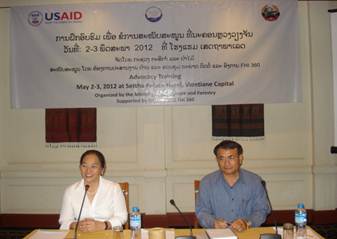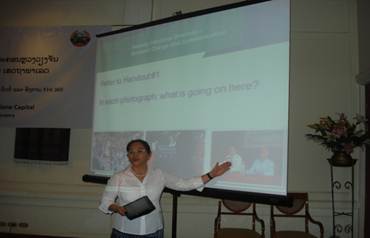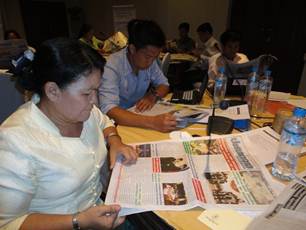
|

|
|
<< MID-BCC home page Blog Home ArchiveBy MonthJuly 2012 (2)June 2012 (1)May 2012 (3)April 2012 (5)March 2012 (1)By CountryCambodia (4)Lao PDR (4)Malaysia (1)Mozambique (1)Vietnam (2)By ProjectMID-BCC (9)PREVENT Project (3)
|
Learning Advocacy: Building From What is Known to UnknownBy Cecile Lantican May 8, 2012 Cecile Lantican, MID-BCC Country Coordinator Lao PDR, facilitated an advocacy training workshop May 2 and 3 for 22 government staff members from the Ministry of Agriculture and Forestry (MOAF) in Vientiane, Lao PDR. Advocacy is a nuanced communication strategy and an important first step in creating behavior change among communities and organizations. Advocacy is well-developed and expertly executed in many countries and cultures, especially in the West. There are some cultures where it is not considered appropriate to advocate for a cause or an issue…and some governments look less kindly on non-governmental advocacy activities. On May 2 and 3 in Vientiane, I facilitated an advocacy training workshop for the government staff from the Lao PDR Ministry of Agriculture and Forestry (MOAF). Our participants were not familiar with the concept of advocacy and subsequently they had no experience with advocating for an issue. This made the workshop both challenging and rewarding.
In planning discussions with Deputy Director General of Planning Dr. Somphan Changphenxay, I noted that equipping the government staff with the needed communication and advocacy skills would enable them achieve more support and services in their government functions as they relate to their stakeholders, organizations, relevant publics and other professionals. The advocacy training was the second communication course, after the risk communication training, which provided the participants the basic concepts and principles of communication and behavior change communication.
My training team was comprised of Khounkham Xaymuonvong and Siamphone Mahindorathep from our MID-BCC Project office. The challenge to us was applying a participatory process to learning about advocacy when it wasn’t a practice they were familiar with. We could not just tell them about advocacy but we needed to show them through good examples and then apply that to their own professional situation. I was mindful of the prior knowledge and background of the participants, how best I could execute the steps proposed in the training guide, and more importantly- how the participants and I could best achieve the learning outcomes. I was also conscious of the process to ensure that I would not miss any step of the guide; it was my first time to use this advocay training guide.My training approach was to engage the participants in a collective learning environment. I, the trainer, and the participants would take the journey to learn together. I believed that our motivation would determine and direct what we do in the training room to learn. The 22 staff were asked to be seated in five round tables, each table provided with a microphone and one computer with access to Wi-Fi. As expected, the participants were able to respond in reference to the three images – the sand bags, HVP vaccine, and protective equipment. Other images, which included the revolutionary waves of demonstration occuring in Arab countries, the Livestrong wristband, and Occupy Wall Sreet movement, were less familiar to the participants.
I distributed back issues of two Lao newspapers – The Vientiane Times (in English) and Pathet Lao (in Lao). I asked participants to read news article and stories that were of interest to them. Thereafter, I asked them to clip images and stories they liked to present the meaning of support, attention, change, policy, and the law. Participants’ prior knowledge could facilitate learning. I shared with them other photos (in my PowerPoint). I took the photos (below) in front of our office the day before the training. Everyone expressed his/her understanding of the message given their awareness of the current advocacy of the city government that people in their motorbikes, young and old, men or women, should wear helmets, otherwise a corresponding penalty will be imposed for violating this transport rule.
|
||
|
Copyright© 2011 FHI360 1825 Connecticut Avenue NW Washington, DC 20009 - 5721 
The Mekong Infectious Disease Behavior Change and Communication Project is funded by the United States Agency for International Development (USAID)/Global Health under Client Associate Award Number GHN-A-00-09-00002-00 under Leader Award (C-Change) No. GPO-A -00-07-00004-00 and managed by FHI 360. The information provided on this site is the responsibility of FHI 360 and is not official information from the U.S. Government and does not represent the views or positions of USAID or the U.S. Government. |
|||

 The advocacy training was aimed to: strengthen the communication capacity of select staff from relevant departments of MoAF; and (2) develop a core group of staff trained in all aspects of communication and that can provide technical support to the Ministry’s communication needs over the long-term.
The advocacy training was aimed to: strengthen the communication capacity of select staff from relevant departments of MoAF; and (2) develop a core group of staff trained in all aspects of communication and that can provide technical support to the Ministry’s communication needs over the long-term.  There were several examples we used in the training – H5N1 virus, floods, and HPV vaccine – that were issues that our participants would relate to…The Thai floods are still a major topic in the region; outbreaks of H5N1 virus are still prevalent in the region; and vaccines are a constant public health priority which is why we focused on these examples. My assistant, Siamphone distributed the first handout. Handout #1 provided various images that exemplified the concepts and terminologies of change, policy, attention, and support. My first question to break their silence: What do you see on these images? What’s going on?
There were several examples we used in the training – H5N1 virus, floods, and HPV vaccine – that were issues that our participants would relate to…The Thai floods are still a major topic in the region; outbreaks of H5N1 virus are still prevalent in the region; and vaccines are a constant public health priority which is why we focused on these examples. My assistant, Siamphone distributed the first handout. Handout #1 provided various images that exemplified the concepts and terminologies of change, policy, attention, and support. My first question to break their silence: What do you see on these images? What’s going on? To augment the examples and make it more relevant to the Lao setting, I replaced the other examples with three images they would be more familiar with. These were the images of Lao men marching in the street with placards of “no to smoking,” the monks supporting the cause, and two prominet people in Vientiane Capital speaking out on the issue.
To augment the examples and make it more relevant to the Lao setting, I replaced the other examples with three images they would be more familiar with. These were the images of Lao men marching in the street with placards of “no to smoking,” the monks supporting the cause, and two prominet people in Vientiane Capital speaking out on the issue.

